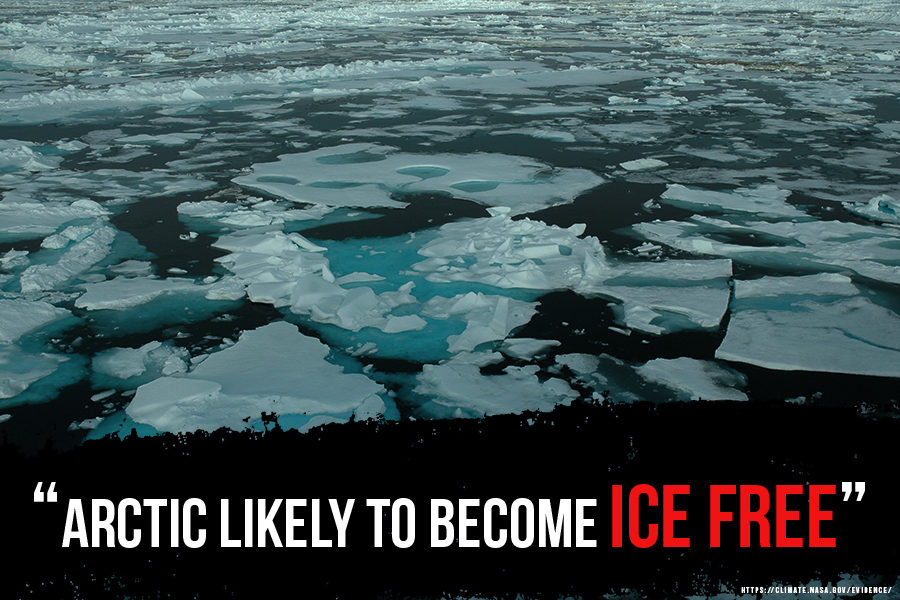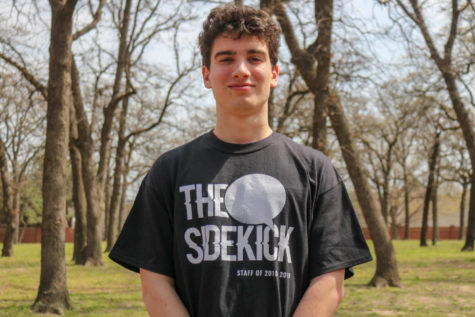Climate Change
The plight inflicting worldwide damage, requiring worldwide attention
March 19, 2019
Hellish fires and hurricanes have swept both headlines and the coasts of the United States in the past year, destroying property and displacing hundreds.
The generation of teenagers who walk the halls of high schools will face the brunt of climate change, being the youngest in the world. Their children, grandchildren and posterity will reel from the effects of a warmer world.
These extreme weather conditions are likely to increase in number and become more severe as time goes on.
The question of what to do about climate change still looms.
The Evidence
The scientific community holds a strong consensus that climate change is a real phenomenon that is largely an effect of human activity.
For decades, researchers have collected data on changing temperatures, sea level, ice sheet areas and atmospheric carbon dioxide. One of these researchers, Texas A&M professor and climate physicist Andrew Dessler, has mapped climate data for years and even served as a part of the Clinton Administration. He, along with other researchers, has noticed trends that seem to worsen over time: sea levels, temperatures, and carbon dioxide levels rise as Arctic ice, wildlife populations and forests shrink.
Carbon dioxide, emitted from the burning of fossil fuels from cars and factory emissions, acts as an insulator blanket in the atmosphere, keeping warmth within Earth. This most directly leads to warmer temperatures across the globe, which triggers a domino effect of geological changes.
Arctic ice, which ebbs and flows seasonally, has seen a net decrease over the years. Sea levels rise as a result of melting land-based Arctic ice as well as the chemical properties of water (which expands as it heats). In addition, ice plays a large role in reflecting solar radiation. The loss of ice means makes the planet darker, absorbing solar radiation and causing warming.
Oceans also become more acidic as carbon dioxide from emissions tends to settle in water and raise pH, disturbing innate aquatic ecosystems. Patterns of precipitation are even affected by rising temperatures, an issue that worries agriculturalists in places such as Texas that are prone to drought, according to Dessler.
Deforestation is also a cause for concern. Plants, especially trees, serve as carbon sinks; they take in carbon dioxide and release oxygen as a result of metabolic processes. The rapid decrease in forest area decreases the amount of carbon sinks that can take in carbon dioxide, keeping it in the atmosphere.
Weather changes could subsequently result in economic and geopolitical difficulties as well.
“The thing we’re most confident about is that temperatures will rise, so summers will get hotter,” Dessler said. “For a lot of people, you can just go inside and turn up your air conditioner, but that will cost you money. And I feel very sorry for people who work outside – the poorest people – and it’s going to be really tough. Productivity will go down.”
Crop failure has driven economic recessions in some countries, leading to civil unrest in some cases. The Syrian Civil War and subsequent refugee crisis have even been postulated as to have resulted from drought caused by climate change, which harmed the economy and weakened the state of government in the country.
Scientists are not only aware of the symptoms of global warming; they have diagnosed the disease.
Scientists, such as Dessler, have statistically analyzed climate feedbacks from satellite data and climate models, which give them an idea of how much warming can be done by a certain amount of carbon emissions.
“These feedbacks are these vicious cycles that amplify the warming with carbon dioxide alone,” Dessler said. “If you want to estimate how much warming you’re going to have in the future, you have to understand how big these feedbacks are.”
He finds the scientific evidence for climate change to be immense, with a clear connection to human activity.
“We are essentially returning the planet to the climate it had millions of years ago,” Dessler said.
The Earth has undergone cycles of warming and cooling, but the pattern of warming experienced now is unprecedented. Scientists attribute this to human activity.
In the past two years alone, the U.S. has seen storms such as Hurricanes Harvey and Maria, not to mention devastating floods and droughts such as the 2010-2013 Southern U.S. and Mexico drought. These natural disasters cost residents and the government money, in possessions lost and aid given, as well as lives.
“[Younger generations are] going to be impacted by this a lot more than my generation and the people in Washington,” Dessler said. “[They] will never live a day in [their lives] in which climate change does not have an effect. [They] may not initially know that these things are affected by climate change, but it will change everything in the world.”
The Obstacles
Per the 2018 United Nations report, the world only has until the year 2030 to limit carbon dioxide emissions before an increase of 1.5 degrees celsius in temperature from pre-industrial levels.
According to both scientists and some members of the general public, it doesn’t necessarily appear that much action is being taken to do so, despite an abundance of data making a case for climate change.
“I don’t think people understand the magnitude of the situation,” Coppell High School junior Angie Smith said. “If you read the statistics about what’s predicted to happen in 2030, it’s scary and it shouldn’t be happening. People should be concerned about it, and they’re not.”
Smith is passionate about the environment and climate change, doing what she can to help the environment.
“At the rate that we’re going, it’s simply not sustainable, and denying that is just ignorant,” Smith said.
Coppell resident Beth Reynolds has done environmental work in Coppell and New York for 15 years, leading children’s camps and public engagement activities as well as working with Coppell parks and the Biodiversity Education Center. Doing such work has given her insight into areas such as sustainability and waste management. Reynolds has many concerns about climate change, particularly inaction on ways to mitigate it.
“I remember in the ‘70s, there was the gas and energy crisis – it just seemed pervasive, like a national campaign to conserve energy and do things differently,” Reynolds said. “I remember making a poster about using less hot water. In school, we were taught about these things; nowadays, it’s such a backburner.”
However, a Yale study found that a growing number of people, namely younger people, are concerned about climate change.
Why does climate change, if it is proven to have destructive effects, not take center stage of public policy and consciences?
Firstly, a few people still have reservations about research done on climate change. The Yale study found that three out of 10 Americans still do not entirely believe in climate change. For the seven who do, the effects of climate change may have not affected them yet.
Secondly, at the heart of political stagnancy lie complex systems that make it difficult to pass laws enacting change.
“When President Obama was in office, he enacted most of his policies by executive order, through the Clean Air Act, and there were a lot of legal challenges to that approach,” Dessler said. “What we really need is to get something through Congress and it’s not at all clear to me what that would take.”
Climate change is now seen as a controversial partisan issue, largely due to a strong influence of oil and gas lobbyists and the sheer power of companies in those industries. Fossil fuels lobbyists spent more than $2 billion from 2000 to 2016 to sway climate legislation in Congress, 10 times the spending of environmental groups and renewable energy lobbyists.
“You look at gun control, and there are certain things that 90 percent of the population agrees on – things like background checks – and they can’t even get a vote in the Senate on this, so I’m a little bit discouraged,” Dessler said. “Even if there is widespread public agreement [on climate policy], it won’t get a vote.”
With the Trump administration, it even seems as if America is taking steps backward in terms of mitigating climate change. As regulations for limits on chemical waste and emissions are repealed by the administration, companies can choose higher profits over environmental consciousness.
Perhaps the most public action taken against climate policy occurred in 2017, when President Donald Trump announced he would pull the U.S. out of the Paris Climate Agreement. The agreement, held by 174 countries and the European Union, includes reduction of emissions and increased public awareness. The U.S. cannot formally rescind its membership until 2020, but it does not seem that the U.S. is formally taking any drastic steps to cut emissions.
“At the national level, it feels like we’re going backwards, pulling out of the Paris Agreement, the way the current administration speaks about climate change,” Reynolds said. “It’s not even accepted that [climate change] is happening – we’re nowhere near taking steps to tackle [climate change].”
With these complications, any policy invoked to mitigate climate change may be too late.
“I am not optimistic that the world is doing enough to combat [climate change] quickly enough,” Reynolds said. “It’s going to take a major crisis – one of catastrophic proportions, like a serious depression – for the world to start doing things differently,”
The Solutions
Per the U.N. report, the planet has already passed to a point of no return, but there is still room to at least lessen the severity of climate-related disasters in the future.
“If we want to prevent warming, we’ve got to cut emissions reasonably rapidly,” Dessler said. “What that basically means is, we need to rebuild our energy infrastructure away from fossil fuels and towards renewable and non-emitting technologies. We have a few decades to do that, maybe by 2050, we should have emissions down well below 20 percent of what they are now. It’s still possible for us to head off the worst impacts, but time is running out.”
Some, such as Reynolds and Smith, think the first step toward a solution to climate change is spreading awareness for the issue; they think there is inaction simply because people are uninformed.
However, they also think knowledge is in vain if no public policy is enacted to effectively curb carbon dioxide emissions and commit countries to sustainable practices.
“It’s going to take a world campaign, or some miracle scientific revolution with respect to taking greenhouse gases out of the air, or with cars – it’s got to be grand, not only ‘do I recycle this plastic bottle or not?’, which is such a complicated thing in of itself,” Reynolds said.
On the international level, environmentalists and scientists like Dessler say the Paris Climate Agreement, while not enough to entirely combat climate change, is certainly a step in the right direction. The agreement was never intended to be final, rather a springboard for further progress.
While it may appear progress is too difficult to achieve or would be enacted too slowly on the federal level of government, scientists and environmentalists also say efforts put forth by smaller communities should not be discounted.
“The bright light on the horizon is that if the federal government does nothing to address [climate change], smaller jurisdictions would take action,” Dessler said. “There is progress being made – just not at the federal level.”
Since the nominal withdrawal of the U.S. from the Paris Climate Agreement and general federal inaction on climate change, 19 states have joined the U.S. Climate Alliance, an organization whose initiatives aim to serve as the first step to combating climate change. California, one of the most threatened states due to wildfires and ocean levels and one of the first states to join the alliance, has led a charge of its own, enacting plans for implementing renewable energy, clean cars, and pollution controls.
Georgetown, Texas uses 100 percent renewable energy, generated from solar and wind power. Texas is a particularly attractive spot for renewable energy; it produces the most wind power in the country. Earlier this year, a Rice University study has shown patterns of sun and wind in Texas are reliable enough that they could provide for all of the state’s energy usage.
“If I were the king of Texas, I would try to aggressively pursue renewable [energy],” Dessler said. “It’s good for the state, improves air quality and builds up industries for export. It’ll have an economic benefit as well.”
Georgetown Mayor Dale Ross said the city’s decision to transition to 100 percent renewable energy was mostly a business-related decision with less emphasis on climate change in a 2017 interview with NPR– a decision that has shown to pay off.
Renewable energy, in this vein, has a double benefit. Prices of solar and wind energy do not swing, as fossil fuel prices often do, which helps the average consumer save money. In addition, jobs can be generated from exporting energy and industrial work.
On the federal level of government, newly elected progressives as well as older members of Congress seem to consider climate policy a high priority. The Green New Deal was formally unveiled on Feb. 7; though it does not come without criticism (for spending and lack of nuclear energy initiatives), it is an encouraging step for environmentalists. Policies such as the Green New Deal may be perceived as radical in a short-term lense, but may ultimately prove successful in tackling both climate change and economic inequality. Spending on renewable energy initiatives could pay off in terms of the number of jobs created to facilitate renewable energy systems.
The concept of environmentally-friendly buildings has been implemented in several areas well. The Biodiversity Education Center in Coppell is completely sustainable and does not require heating and electricity from fossil fuels. Solar panels at the center produced 24,478.8 kilowatt hours in 2018 of the 89,196.7 kilowatt hours consumed by the center. Rainwater is collected in a cistern and use to water gardens surrounding the center. These sustainable practices could serve as a model for energy-efficient buildings.
“We have had visitors walking the park, talk with us about our building materials since they were going to be building their own homes and want to have a sustainable home,” Maura Reed, the Biodiversity Education Center Coordinator, said via email. “Rain barrels, solar panels and proper insulation are the items they decided were most attainable for their needs.”
Smaller towns such as Coppell could play a unique role in environmental protection; if action on international, federal or state levels is slow, initiatives taken by smaller towns could very well pave the way for larger reforms. Programs such as those promoted by the Biodiversity Education Center as well as groups and committees such as Keep Coppell Beautiful could also play a role in spreading public awareness for sustainability.
“We make it our mission to provide hands-on environmental education programs for both schools and the community to develop a deeper connection to nature,” Reed said. “The deeper the connection, the more likely people are to recycle, compost and save energy.”
With population and urban growth a large factor in the difficulty of mitigating climate change, new buildings engineered to be eco-friendly could prevent further contribution to emissions and spread awareness.
A solution to climate change would require massive collaboration between nations and separate initiatives, according to scientists such as Dessler and groups such as the U.N. While current proposals are nowhere near final solutions, they build a foundation for cumulative effects.
“I wouldn’t be so passionate about climate change if I didn’t think anything could be done about it,” Smith said. “If every person truly put out an effort, the planet could be saved … we don’t really have a lot of time.”
Ultimately, Dessler thinks the driving force to enact any change would have to come from the average citizen.
“Everybody should take virtuous individual actions to walk instead of drive, and maybe eat less meat; those things will save you money and you’ll be healthier,” Dessler said.
Generation Z and those to follow have a unique problem on their shoulders, according to Dessler.
“You need to take some responsibility for securing your own future,” Dessler said.
“Look at politicians, ask what their views on climate change are, and if climate change is something you’re passionate about, take that into account when you’re voting … it’s the only way we’re going to solve problems.”
A citizen can petition their government and spread awareness, oftentimes more effectively than a government itself.
“It’s going to be really telling to see what happens in this next round of presidential elections, and this new Congress,” Reynolds said.
Recent climate marches led by young activists (such as those in Belgium and a series of marches in Britain on Feb. 15) have been inspired by Greta Thunberg, a 16-year-old student who went on strike in front of the Swedish Parliament in 2018. These marches echo sentiments of the People’s Climate March and the March for Science in 2017, as they bring worldwide attention to climate change.
In addition, a group of 21 young plaintiffs have sued the U.S. Government (in the case Juliana v. United States) for violating their rights by permitting activities conducive to climate change, thereby infringing on a right to life, liberty and happiness. There have been numerous instances in which the government attempted to block the case; it will be reviewed by the Ninth Circuit, but the trial may never happen. Nevertheless, it has paved the way for future action.
“Back to individuals who are passionate about climate change – are there enough of them to make their voice heard, as opposed to the voices that are passionate about other topics?” Reynolds said.
The message of scientists, U.N. researchers, environmental groups and those affected by climate change is resounding: never has there been an issue so global and severe than the issue of climate change.











